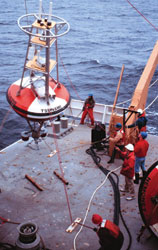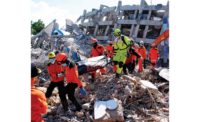 |
| Buoys are ultrasensitive, tethered to ocean floor. (Photo courtesy of NOAA) |
The $30-million global tsunami warning system proposed Jan. 20 in Kobe, Japan, was welcome news to Jack Rynn, director of research at the Centre for Earthquake Research in Queensland, Australia. He published a series of papers in 1996, 1999, and 2001 on the threat of tsunamis in Fiji, Australia and the Indonesian region.
But Rynn is not surprised that that a call for a global warning system, put forth at the United Nations Educational, Scientific and Cultural Organizations (UNESCO) five-day World Conference on Disaster Reduction, did not come until some 225,000 people died. Nor is he shocked at the jockeying for position from countries who would like to run the system. Koichiro Matsuura, director-general, UNESCO, speaking at a press conference at the Mauritius International Meeting on Small Island Developing, says a warning system for the Indian Ocean could be functional by June 2006 and a global system in place a year later at "a fraction of the economic cost of the disaster." A total of $8 million was pledged at the Kobe conference$4 million from Japan, $2.6 million from the European Commission and $1.5 million from Sweden. This would cover the first year of operations for the system, according to a UNESCO official. Japan, China, the U.S. and India have all proposed their own plans and funding for similar systems.
 |
| Warning systems would do little to prevent damage, but they could save lives. (Photo courtesy of Dept. of Defense/Michael L. Bok) |
Rynn, a seismologist by training, has spent the last 40 years in disaster management all over the world. His report, A Preliminary Assessment of Tsunami Hazard and Risk in the Indonesian Region, started with this warning: "The natural hazard of tsunami has, for too long, been underrated as a potential cause of major disasters." The report looks at historical data on tsunamis dating back as far as 2000 BC in what he calls "a very complex and violent tectonic zone." He identified 179 destructive Indian Ocean tsunamis. Compared to the number of other natural disastersfloods, drought, tropical cyclones, the area endures each year, tsunamis have just not been common enough to demand the resources to put a warning system in place, Rynn explains.
The Dec. 26 magnitude 9 earthquake in the Sumatran subduction zonethe largest temblor in the world in the last 40 yearsand the resulting waves have grabbed the worlds attention. "There are a number of challenges with creating a warning system in the Indian Ocean," Rynn says. "The most important are not scientific."
Geoscience Australia recommends expanding the local monitoring equipment to include 30 seismographs, 10 tidal gauges and six $250,000-each Deep Ocean Assessment and Reporting of Tsunamis DART buoys. At a cost of $20 million, that would only be the beginning. "It has to be a complete system," Rynn says. "Its not just a matter of scattering a few instruments." That "system of systems" as the U.S. is calling it, must include a method of coordinating data and communicating information without causing a panic.
For instance, the Hyderabad-based National Geophysical Research Institute reported 27 aftershocks with an intensity of magnitude 6 or above in the Andaman region where the Burma microplate and the India plate have created a nearly 100 km trench. This has not resulted in 27 tsunamis. And not all tsunamis are caused by earthquakes. Some are attributed to underwater volcanic eruptions or mudslides. That is why almost all of the plans call for a combination of seismology and wave recorders to get the most accurate predictions. The most sensitive are battery-powered sensors developed by Seattle, Wash.-based Pacific Marine Environment Laboratories, working with the National Oceanic and Atmospheric Administration. Anchored to the ocean floor, these devices monitor seawater pressure with a resolution of approximately 1 mm every 15 seconds on average. An acoustic "heartbeat" is sent every hour to a pair of control unit companion transducers floating on the surface. Data showing a disturbance as small as 1 cm, kicks the device goes into Tsunami Response Mode. Information is sent via a global positioning satellite special channel through a antenna to a network of dedicated watchers. "It is a very direct, intimate way of measuring the actual impact," says Frank Gonzalez, a scientist with the National Oceanic and Atmospheric Administrations Pacific Tsunami Warning Center.
Then comes the hard part, determining what is a real emergency and letting people in rural areas know what to do. Even the $30 million U.S. proposal by U.S. Sen. Joseph Lieberman (D-Conn.) to expand the over 50-year-old multi-national Hawaii-based Pacific Tsunami Warning System and add as many as 50 of the DART-type sensors in the Atlantic and Indian oceans equipped with two-way capability to allow more research, still leaves a critical communication challenge. It includes $20 million for implementation and maintenance and would make the U.S. Departments of state and commerce responsible for administration, according to a statement from Lieberman's office. Experts say it could cost much more than that to establish the communication and education infrastructure to ensure people respond appropriately to the next incident. "You have to develop a culture of awareness," Gonzalez says.
In the Pacific, that includes outreach efforts at schools and in communities, established evacuation routes and designated contacts to get the word out. While people minutes from the disaster might not have been saved, a system for warning those where the waves hit as much as two hours after they were detected by the Pacific Tsunami Warning System could have saved thousands. "Five minutes is enough time to run inland and save your life," Gonzalez says.
The Indian press has criticized the preparedness of that country to communicate, a problem that cost as many as 12,000 lives. Only the Indian Meteorological Department is authorized to put out hazard alerts. "Data were pouring into our lab but we cannot issue alerts even if we can analyze the data for tsunami potential," the InterPress Service quoted one researcher at the National Geophysical Research Institute in Hyderabad.
An international scientific committee is scheduled to meet in Paris in March to hammer out the details and create a multi-national plan that before the world loses interest again.


Post a comment to this article
Report Abusive Comment